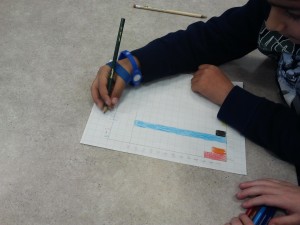Data Analysis and Problem-Solving in Second Grade
 What a treat it was for me to work with two second graders yesterday in Mrs. Durbin’s class. Mrs. Durbin created a fun project for these two high math students to provide them with extra challenge. I’m there to help facilitate them while she teaches the rest of the class.
What a treat it was for me to work with two second graders yesterday in Mrs. Durbin’s class. Mrs. Durbin created a fun project for these two high math students to provide them with extra challenge. I’m there to help facilitate them while she teaches the rest of the class.
When I arrived for my first session with them last week, they had already collected their data. Their chosen topic was sports equipment in the primary grades. They wanted to find out how many soccer balls, jump ropes, etc. each primary classroom has. I entered the scene at the point of organizing the data. It didn’t take them long to figure out they wanted to display the data using a bar graph.
What was fun was helping them figure out how to show 28 jump ropes when their graph paper was only 20 boxes high. “Do you have to go by ones?” I asked after they began discussing continuing the bar on the back of the paper. The lightbulb went on and they decided that going by twos would work just fine. They had to stop and think again when I asked them to show me how to represent 5 kick balls.
But yesterday was a really fun day because I got to see them think at a pretty high level. Here’s how it happened. They wanted to make their title colorful. So they chose 6 pencils of different colors and counted out the number of letters in the title which was 15. They were hoping to use each color the same number of times. “Hmmm…” started one of them, “18 is too high. We’ll need to take a pencil away. Yeah, that would work.”
I was quickly recording his words so I wouldn’t forget and then asked, “How did you arrive at that?”
“Well, I counted 6, 12, 18 and 18 is too many. So if we took one pencil away, it would be 5, 10, 15 and that would work.”
“Wow. You’re counting in multiples of 5 and 6,” I said to reinforce the vocabulary word ‘multiples’. Then I asked him how many times they would use each color and he quickly responded with three.
That’s an example of great thinking and great problem-solving. I was pretty impressed. Given the opportunity, it’s amazing what students can do. As teachers, we need to be on the lookout for good problems that allow students to think on a deeper level. This helps build their confidence in their ability to do math. And it makes math interesting. And fun.
Note: It turned out they added 3 letters to their title and ended up with 18 letters. They went back to the original 6 pencils.